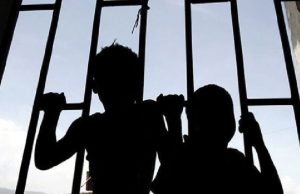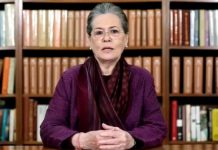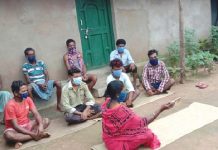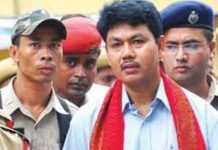 Recitation of the preamble of Constitution ad nauseum at every opportunity during any public gathering became endemic during last few months. The purport, thereof, ostensibly was to ward off the assumed evil effects of CAA. As a consequence thereof, the mesmerizing impact struck the juvenile minds, who, apparently of their own, joined or were cajoled to join the protests at Shaheen Bagh and elsewhere under the garb of their right to peaceful protests.
Recitation of the preamble of Constitution ad nauseum at every opportunity during any public gathering became endemic during last few months. The purport, thereof, ostensibly was to ward off the assumed evil effects of CAA. As a consequence thereof, the mesmerizing impact struck the juvenile minds, who, apparently of their own, joined or were cajoled to join the protests at Shaheen Bagh and elsewhere under the garb of their right to peaceful protests.
The moot point of discourse here is, whether a minor, who legally, is a person under legal disability, has any independent right of his own, and whether for self created enforcement of which, he could lawfully protest in a public place. A perusal of all the legal provisions available to such a person under disability under the Constitution, completely rules out such a Machiavellian interpretation.
Under Section 3 of the Indian Majority Act, 1875, which is applicable to all persons domiciled in India, irrespective of their personal laws, religious beliefs, political leanings etc., for the last one hundred and fifty years, every person shall attain the age of majority on his completing the age of eighteen years and not before. Even under the International Convention of the Rights of the Chid, 1989, Article 1 whereof states that “A child means every human being below the age of eighteen years unless under the law applicable to the child majority is attained earlier.” The Government of India has ratified these international treaties related to the association of children with non-state armed groups.
A child is also defined as anyone under 18 years of age under the following Indian national laws and policies:
◆ The Juvenile Justice (Care And Protection Of Children) Act, 2015 (JJ Act)
◆ National Policy for Children, 2013
◆ Protection of Children from Sexual Offences Act (2012)
Under the Indian Constitution, to which all anti CAA protesters, inter alia, the “child protesters” vociferously vouchsafe, the primary responsibility to nurture, protect, discipline and look after the overall welfare of such minors, rests with the parents. Under the legal jurisdiction of any civilized society, the right of custody accorded to parents springs from the exercise of parental authority. Parental authority or patria potestas in Roman Law is the juridical institution whereby parents rightfully assume control and protection of their un-emancipated children to the extent required by the latter’s needs. It is a mass of rights and obligations which the law grants to parents for the purpose of the children’s physical preservation and development, as well as the cultivation of their intellect and the education of their heart and senses. As regards parental authority, “there is no power, but a task; no complex of rights, but a sum of duties; no sovereignty but a sacred trust for the welfare of the minor.”
Parental authority and responsibility are inalienable and may not be transferred or renounced except in cases authorized by law. When a parent entrusts the custody of a minor to another, such as a friend or godfather, even in a document, what is given is merely temporary custody and it does not constitute a renunciation of parental authority. Even if a definite renunciation is manifest, the law still disallows the same. Parental authority and responsibility are inalienable and may not be transferred and renounced except in cases authorized by law. The rights of parents vis-à-vis that of their children are not antithetical to each other, as in fact, they must be respected and harmonized to the fullest extent possible. The law is clear that either parent may lose parental authority over the child only for a valid reason, since parental authority is a constitutionally protected State policy borne out of established customs and tradition of our people.
The best interest of the child can override procedural rules and even the rights of parents to the custody of their children. Since the very life and existence of the minor is at stake and the child is at an age where he can exercise an intelligent choice, the courts can do no less than respect, enforce, and give meaning and substance to that choice and uphold his right to live in an atmosphere conducive to his physical and moral, as well as intellectual development.
The paramount consideration is always the best interests or welfare of the child. This is because the child is considered as one of the most important assets of the nation. The Convention on the Rights of the Child also provides that “in all actions concerning children, whether undertaken by public or private social welfare institutions, courts of law administrative authorities or legislative bodies, the best interests of the child shall be a primary consideration. The Constitution also provides that, “the State shall defend the right of children to assistance, including proper care and nutrition, and special protection from all forms of neglect, abuse, cruelty, exploitation, and other conditions prejudicial to their development.
However, when the welfare of a helpless child is at stake, as is discernible in the case of “child protesters” in Shaheen Bagh and elsewhere, it is the duty of the courts, which they cannot shirk to perform, to respect, enforce and give meaning and substance to a child’s natural and legal right to live and grow in the proper physical, moral and intellectual environment. The Court’s intervention is necessary so as to prevent the rights of the child from becoming mere declarations without any force and effect whatsoever. The constitutional mandate that recognizes the primary and natural right belongs to the parent in the rearing of children at the same time recognizes the secondary and supportive role of the State.
The State is justified in such interference since the Constitution itself made it the avowed policy of the State to promote the welfare of the youth and to provide for their protection. Thus, the judiciary, as an agency of the State in its role as parens patriae, is called upon whenever a pending suit of litigation affects a minor in order to give priority to his best interest.
A child’s interest in being in the care of an adult who will provide the best possible protection, nurture, and upbringing is one aspect, while the other is the interest of an adult who seeks the custody or companionship of the child. The third aspect is the society’s interest in the form and function of the family, particularly as a child-rearing institution. When both the first two eventualities fail to work, the third, that is, the government is within its duty to protect and to control persons under disability. Conceptually. the parens patriae theory is the obligation of the stale to protect and take into custody the rights and the privileges of its citizens was discharging its obligations.
Under article 225 of the Constitution of India as parens patriae, which according to Black’s Law Dictionary, literally means ‘parent of the country’ and refers traditionally to the role of the Court / State as protector of persons under disability. the Supreme Court could issue directions, which despite the pendency of petitions before it pertaining to blockage of public roads in Shaheen Bagh and other cognizable matters, for the reasons best known to it, avoided to do so, despite the fact that the controversy as to whether any protester had the right to block or encroach upon any public road, had already been authoritatively settled by a 5-Judge Bench of the Supreme Court in 1972 in the case of Himat Lal K. Shah vs. Commissioner of Ahmedabad Police and later in the years 2016 (Anita Thakur vs. State of J&K) and 2018 (Bimal Gurung vs. Union of India).
However, when another statutory specialized instrumentality of State, that is, the National Commission for Protection of Child Rights (NCPCR) on 1th Dec., 2019 issued an advisory under section 13(1)(j) of the Commissions for Protection of Child Rights Act, (CPCR Act) 2005, to the District Magistrate of South East Delhi to identify the children involved in Shaheen Bagh protests and send them for counselling. In its advisory, the NCPCR said the children “may suffer from mental trauma” because of “rumours and miscommunication” regarding the CAA. This order was based on viral videos, which showed children saying things like ‘Pradhan Mantri humko desh se nikal denge (the Prime Minister will throw us out of the country)’, and ‘Home Minister ko kaagaz nahi dikhayenge toh who humein detention camp mein bhej denge (if we don’t show documents to the Home Minister, he will send us to detention camps)’. This is the effect of rumours regarding CAA. For the children to be affected by this and say things like this is extremely worrying. We believe the children are in need of intense counselling. If need be, their parents should also be sent for counselling,” advised the chairperson NCPCR Priyank Kanoongo, to whom prima facie it appeared that the children have suffered from deep trauma because of the “rumours floating around”. He said local counselling centres are available to this end.
Section 83 of the Juvenile Justice Act states that any non-State, self-styled militant group or outfit declared as such by the Central Government, if recruits or uses any child for any purpose, shall be liable for rigorous imprisonment for a term which may extend to seven years and shall also be liable to fine of five lakh rupees. Further, Section 83 and 86 of the Juvenile Justice Act make recruitment and use of children by non-state militant groups a cognisable and non-bailable offence. The juvenile justice system is bound by key principles of juvenile justice and child rights in any decision or action taken by the authorities while implementing the Juvenile Justice Act.
Among the key principles are the principles of best interest of the child, equality and non-discrimination and safety of children, principles of positive measures and diversion, the principles of participation and natural justice along with a right to privacy and confidentiality throughout the judicial process and use of institutionalisation as a measure of last resort.
The Juvenile Justice (Care and Protection of Children) Act, 2000 got replaced by this most comprehensive law to deal with children’s right. According to this Act, a ‘juvenile’ is a person, who has not attained the age of eighteen years. This Act lays down ground rules for handling cases of juveniles either in conflict with laws or those in need of care and protection. It also provides the rehabilitation and social reintegration of a child shall begin during the stay of the child in a children’s home or special home and for their ultimate rehabilitation through various institutions established under this enactment.
According to Section 8(3)(c) of the JJ Act, Juvenile Justice Boards must ensure the availability of legal aid for a child in conflict with the law through legal services institutions. A similar responsibility rests with the Child Welfare Committee under Section 30 (xvii) for children in need of care and protection. Under the JJ Act no child in conflict with the law can be sent to a prison, except where a 16 to 18 years old child is transferred to and tried by the Children’s Court and is found guilty of committing a heinous offence. Even in such a situation, as per Section 20 of the JJ Act, the child will be detained within the juvenile justice system until the age of 21 years. On attaining the age of 21 years, the child may be released on certain conditions or shifted to a prison to serve the remaining sentence, subject to an evaluation as to whether the child has undergone any reformative changes and can be a contributing member of the society.
Under Section 18 of the JJ Act, Juvenile Justice Boards can order a number of actions to deal with children in conflict with the law short of trial, inter alia, (i) sending a child home after appropriate inquiry and counselling to such child and to his parents or the guardian; (ii) directing the child to participate in counselling or take part in community service (iii) Directing the child to be released on probation of good conduct (iv) directing the child to be sent to a special home, for such period, not exceeding three years, as it thinks fit, for providing reformative services including education, skill development, counselling, behaviour modification therapy, and psychiatric support, or sent to a place of safety (v) Ordering the child to attend school or a vocational training centre or therapeutic centre, or undergo a de-addiction programme.
During their interactions with the media, the self-acclaimed child rights activists raised paradoxical rants, on one hand deprecating the statutory NCPCR’s suo moto advice to directors general of police and the district magistrate of South-East Delhi to take action as per law and on the other hand calling upon the State to ensure that the “child protesters” are facilitated to exercise their right to self-expression — either to dissent or to endorse, to exercise their right to peaceful assembly and to engage meaningfully in public discourse. Even though under any law for the time being in force, there is no provision which enables any child to enforce any of his rights , either through the judicial power of the state or through any other independent means except those through their natural or court appointed guardian, yet, as per these rabble rouser activists, the State was duty-bound to provide safety and security to such “child protesters” to ensure that (self created) rights of such juveniles were upheld not only prior to or during their engagement, but also that they do not face any backlash for their present views, howsoever, wrongful or atrocious these may be.”
The judiciary through its judgements successfully has been able to bring child rights to the mainstream of human rights discourse and in entreating greater accountability from the government agencies for the protection of child rights. Needless to reiterate that Article 21 of the Constitution, which can be termed as the Magna Carta of Human Rights, guarantees right to life and liberty to every human being including the children. Justice is everybody’s right. Children’s justice is to be ensured by adults because they cannot lobby for themselves. Under the facts, circumstances and a catch 22 situation created by the protagonists spearheading anti-CAA protests, the “child protesters” are in need of care and protections on any of the grounds mentioned herein. (i) whose parent/guardian is unfit to control the child; (ii) who is or is likely to be exploited for illegal acts; (iii) who is a victim of civil commotion like the present anti-CAA protests.
Child of today cannot develop to be a responsible and productive member of tomorrow’s society only by clamouring for exercise of rights sans corresponding duties towards the nation and unless an environment which is conducive to his social and physical health is assured to him. Neglecting such deluded “child protesters” means loss to the society as a whole. Therefore, under the much-trumped Constitution preamble, an onerous task lies ahead for the State as parens patriae to reform such wayward juveniles and instil in them the inseparable rights and duties concept.
YK Kalia is a Pro Bono Consultant, Advocate, Punjab & Haryana High Court with forty years in-depth experience in legal profession. Views expressed are his own
letters@tehelka.com












